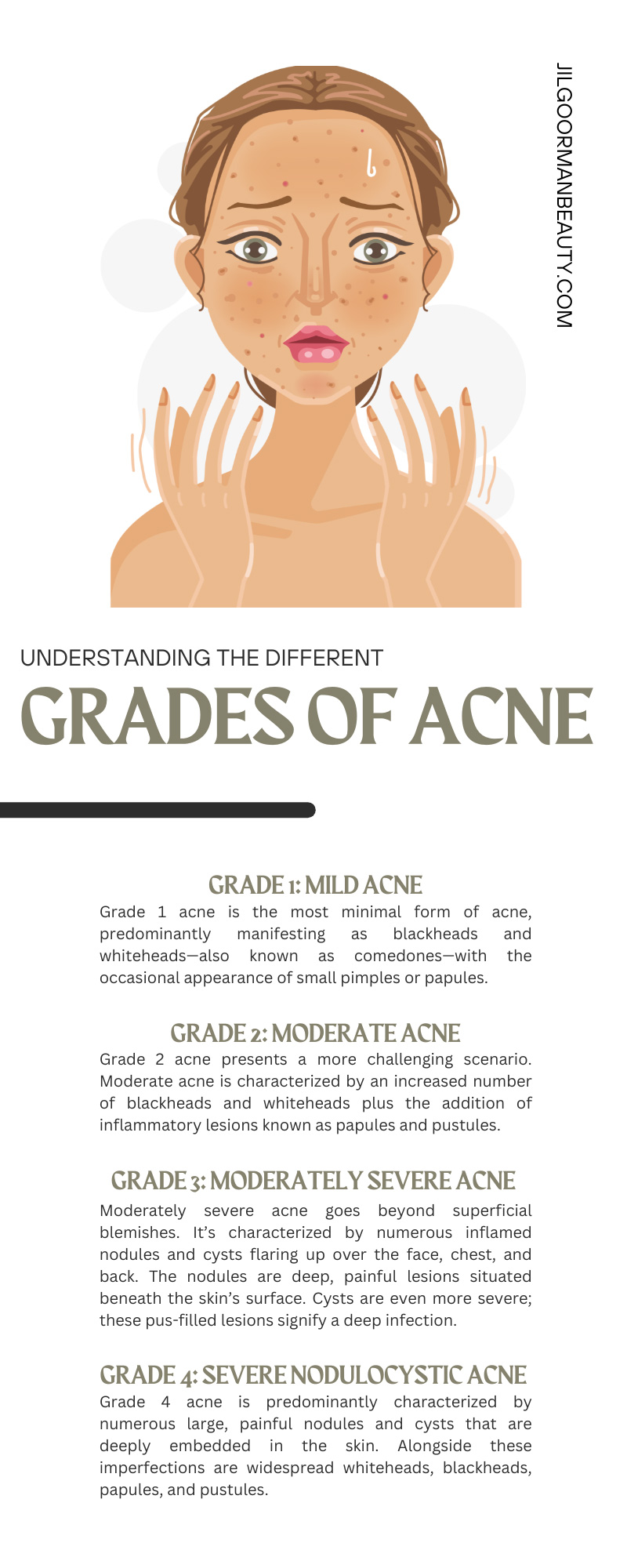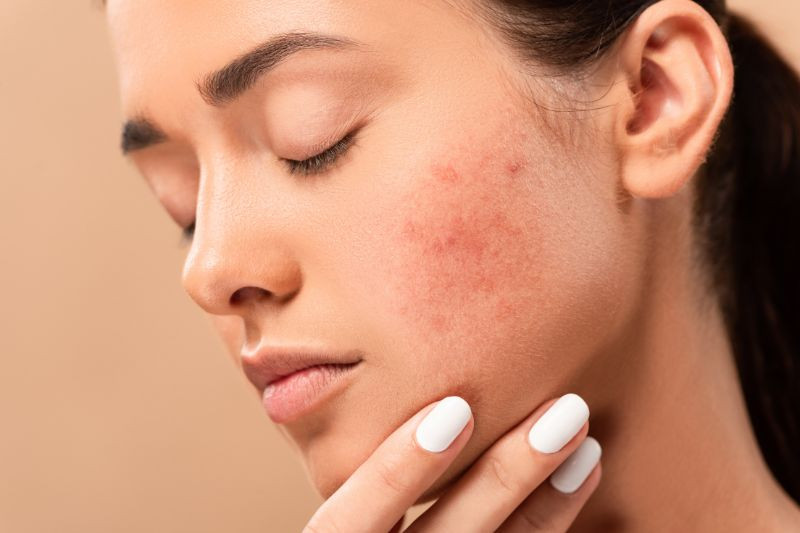Severe acne outbreaks or even just a few small pimples can feel painful, lower self-esteem, look unsatisfactory beneath makeup, and discourage social interactions. But there’s no one cure that will suit everyone’s acne symptoms. Understanding the four different grades of acne is imperative to properly treating this skin condition.
Grade 1: Mild Acne
Grade 1 acne is the most minimal form of acne, predominantly manifesting as blackheads and whiteheads—also known as comedones—with the occasional appearance of small pimples or papules. These are often concentrated in the T-zone: the forehead, nose, and chin, where the sebaceous glands are more active. Unlike more severe forms of acne, Grade 1 acne does not typically lead to scarring, since the inflammation is minimal and confined to the surface layer of the skin.
How To Treat Grade 1 Acne
Effectively treating Grade 1 acne starts with incorporating a simple but consistent skin-care regimen. Wash your face daily with a noncomedogenic cleanser to remove excess oil and debris from the surface of the skin. Avoid harsh scrubbing or over-washing, as you risk irritating the skin and worsening your acne with these actions.
After cleansing, applying a mild over-the-counter acne treatment containing active ingredients such as salicylic acid or benzoyl peroxide, which will kill any lingering bacteria. Finish your routine with a lightweight, oil-free moisturizer to maintain hydration and natural oil production.
Grade 2: Moderate Acne
Grade 2 acne presents a more challenging scenario. Moderate acne is characterized by an increased number of blackheads and whiteheads plus the addition of inflammatory lesions known as papules and pustules. These are red, swollen bumps that may contain pus due to the body’s response to bacterial overgrowth inside the pores.
Unlike Grade 1 acne, these lesions are not limited to the T-zone—they can spread to other areas of the face and, in some cases, to the chest and back. The presence of inflammation indicates the acne has penetrated deeper into the skin layers, posing a greater risk for scarring if not properly treated.
Hair follicles and sebaceous glands can become inflamed due to hormonal fluctuations or accumulated dead skin cells, which can cause an increase in oil production and the proliferation of Propionibacterium acnes (P. acnes) bacteria on the skin. These bacteria can trigger an immune response, leading to the formation of pus-filled lesions.
How To Treat Grade 2 Acne
Over-the-counter products containing benzoyl peroxide and salicylic acid are beneficial. However, dermatologists recommend incorporating topical retinoids into treatment plans. Retinoids encourage and regulate skin cell turnovers to prevent clogged pores.
In some cases, a doctor will prescribe oral medications such as antibiotics or hormonal treatments to treat the root cause. Creating a consistent skin-care routine can also significantly reduce the effects of Grade 2 acne and prevent its progression to more severe forms.
Grade 3: Moderately Severe Acne
Moderately severe acne goes beyond superficial blemishes. It’s characterized by numerous inflamed nodules and cysts flaring up over the face, chest, and back. The nodules are deep, painful lesions situated beneath the skin’s surface. Cysts are even more severe; these pus-filled lesions signify a deep infection.
The development of Grade 3 acne is typically linked to a combination of factors, including genetics, hormonal imbalances, and environmental triggers. Hormones such as androgens increase the production of sebum, an oily substance that can clog pores when overproduced. Sebum combines with dead skin cells for an environment in which P. acnes bacteria thrive.
Grade 3 acne also comes with a higher risk of scarring. Since the inflammation deeply penetrates the skin tissue, it’s quite difficult to heal. Professional intervention and medical treatments are necessary to mitigate permanent scarring.
How To Treat Grade 3 Acne
Managing Grade 3 acne starts with a dermatological consultation. Dermatologists may suggest a comprehensive approach that includes both topical and oral treatments. Topical treatments may include higher concentrations of benzoyl peroxide and retinoids, while oral medications could involve isotretinoin—a powerful drug reserved for the most severe cases—as well as antibiotics to fight infection.
Additionally, procedures such as chemical peels, laser therapy, or drainage and extraction may lessen redness and inflammation. With consistent treatments, improving the skin’s overall appearance is possible.
Don’t forget one of the most important tactics to implement at home: avoid squeezing or picking at the lesions. This action might feel satisfying in the moment, but it could cause additional painful breakouts and encourage acne scars.
Grade 4: Severe Nodulocystic Acne
Also known as cystic or severe nodulocystic acne, Grade 4 acne is the most relentless grade, surpassing average blemishes. Grade 4 acne is predominantly characterized by numerous large, painful nodules and cysts that are deeply embedded in the skin. Alongside these imperfections are widespread whiteheads, blackheads, papules, and pustules.
In this case, the body has had an intense inflammatory response to the overproduction of sebum, cellular debris, and P. acnes bacteria within the skin. The underlying causes include hormonal fluctuations, genetic predispositions, and possibly lifestyle factors that exacerbate the skin’s oil production and inflammation. Grade 4 acne covers the face, chest, back, and shoulders. Every extensive breakout causes significant distress, deep tissue damage, and a high risk of scarring.
The cysts and nodules are the results of an immune response to bacteria, coming with troublesome redness as well as immense pain and swelling. The depth of these lesions makes Grade 4 acne especially challenging to treat.
How To Treat Grade 4 Acne
Guidance from a dermatologist is imperative. Treatment plans often include isotretinoin, which significantly decreases sebum production, inflammation, and bacterial growth. Isotretinoin can offer hope for substantial improvement, but it also carries the risk of serious side effects.
Corticosteroid injections are complementary to medication. They diminish cyst size and redness.
Embark on a Journey to Clearer Skin
The last valuable piece of information to understand about the different grades of acne is that none of these conditions will disappear overnight. Some will take several months to see improvement, while others could take years.
The secret to reduced inflammation, fewer breakouts, and less painful cysts or nodules is the formulation of a routine using clean skin care for acne. Jil Goorman Beauty wants to be part of this process. Eliminating acne and minimizing scarring are impossible to take on alone. With guidance from a dermatologist and Jil Goorman Beauty’s selection of acne-safe skin care, you’ll be on the right path to clear, radiant skin.


